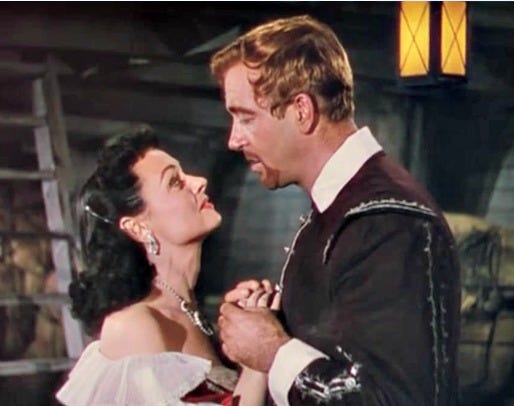Raiders of the Seven Seas (1953)

John Payne's beard was not very red, despite carrying the Spanish name for "Redbeard" in "Raiders of the Seven Seas," a film that at one time was to share the moniker of its main character, Barbarossa. But he's a stolid, charismatic presence in this mid-century example of B-movie high adventure, co-starring Donna Reed as the ubiquitous love interest.
The sea battles are just terrible, a mix of stock footage, chintzy-looking model ships and snippets from other movies. Director Sidney Salkow re-uses shots over and over again, including an exceedingly strange one of Barbarossa's merchantman seemingly plowing through the waves — except it never moves forward.
Granted, this was low-budget spectacle. But compared to the magnificent sea battles in "Damn the Defiant!" from just nine years later, the ones in "Raiders" look positively amateurish.
Forget about historical accuracy; the real Barbarossa was a 16th-century Ottoman who never made it west to the "Caribbes," where his film doppelganger plunders Spanish ships and townships with glee. He's got a writ from the opposing French government granting him authority to make war on their enemy, a common tactic during the golden age of piracy when the line between outlaw and hero often grew faint.
Payne, best known for film noir roles and the lead in "Miracle on 34th Street" — and also as screenwriting legend Robert Towne's father-in-law — plays Barbarossa as a full-blooded man of passion. He loved gold, women, food and humiliating his enemies, and not necessarily in that order. Of course, his appetites are brought to heel by the attentions of a beautiful woman, Alida (Reed).
A noblewoman who acts as governor of Tortuga in her father's absence, the strong-willed Alida becomes Barbarossa's prize trophy, to be sold back to the Spanish for 50,000 pieces of goal. Her arranged-marriage fiance, Captain Jose Salcedo (Gerald Mohr), plays the heavy of the piece. He'd rather risk his would-be wife's life than pay the gold and give up a chance at Barbarossa's head.
Lon Chaney Jr. shows up as Peg Leg, a slave whom Barbarossa frees along with a whole galley of subjugated men. True to his name, Peg Leg is missing a limb, which, of course, the real Chaney did not. They use the old tie-the-leg-behind-him trick, complemented by an entire menagerie of objects and pieces of the set that conveniently get in the way of his profile. Still, you can see the ruse if you care to look closely enough.
Everyone in the movie speaks in an arch, oddly formal way as if they were addressing each other for posterity rather than mere communication. Salkow co-write the script with John O'Dea, filling it with familiar tropes of the buccaneer genre. A peppy little boy named Datu even shows up to act as the pirates' cheerleader and mascot; normally this sort of role is played by an ethnic minority to give the movie a little zing of exoticism, but here young Norwegian Skip Torgerson keeps things lily-white.
The tiny scale of the film is easy to see in relation to what it is supposed to represent. Salcedo at one point has 1,500 Spaniard soldiers under his command, but somehow we never actually see more than 20 of them at once, and seemingly the same 20 over and over again. Similarly, Barbarossa eventually captures a whole fleet of ships, but they're seemingly manned by the same handful of henchmen.
"Raiders of the Seven Seas" isn't a bad movie, just a cheap one. It's the sort of thing you saw on the bottom of a double-feature back in the day, munched your popcorn and enjoyed, and quickly forgot about.
3 Yaps



